NUST Institute of Civil Engineering (NICE)
School of Civil and Environmental Engineering (SCEE)
National University of Sciences and Technology (NUST)
H-12, Islamabad, Pakistan
Seismic Hazard Parameters for Major Cities of Pakistan (BCP-2021)
The Building Code of Pakistan (BCP-2021) incorporates the results of an updated probabilistic seismic hazard analysis (PSHA) of the country. This PSHA is conducted using sate-of-the-art methodologies and up-to-date data sources. It employs an improved seismic source model and considers the contributions of several major crustal faults in the country. Several improved ground motion prediction equations are used in a logic tree framework to account for uncertainties. The maps below shows the short-period (Ss) and long-period (S1) spectral acceleration values for a return period of 2475 years obtained as a result of this improved PSHA. These values are not modified for the target risk (1% probability of collapse in 50 years) according to the hazard definition of ASCE 7-16 (and IBC-2021). The presented hazard maps and hazard parameters are recommended to be used with the BCP-2021 (IBC-2021 and ASCE 7-16) seismic design procedures.
The following team has participated in the updated PSHA at different stages.
Team Leaders: Dr. Muhammad Asif Khan & Prof. Dr. Qaiser Ali
Members: Dr. Muhammad Waseem, Dr. Muhammad Ali Shah, Dr. Shahid Ullah, Dr. Saeed Zaman, Dr. Fawad Ahmed Najam, Dr. Irshad Ahmad, Adnan Alam Awan, Dr. Zahid Rafi, Dr. Talat Iqbal, Dr. Muhammad Javed, Syed Kazim Mehdi, Zulfiqar Moin, Muhammad Imran.
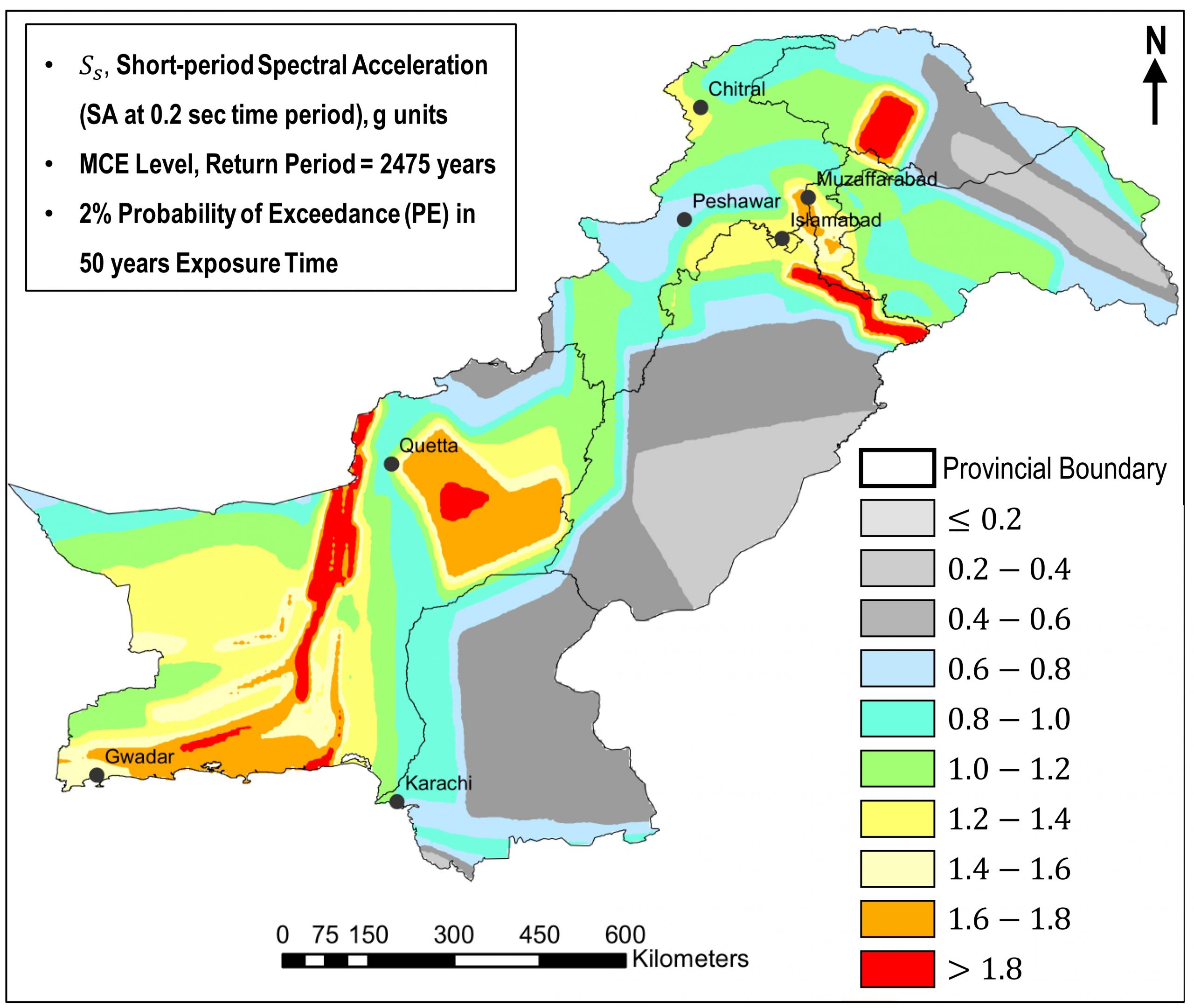
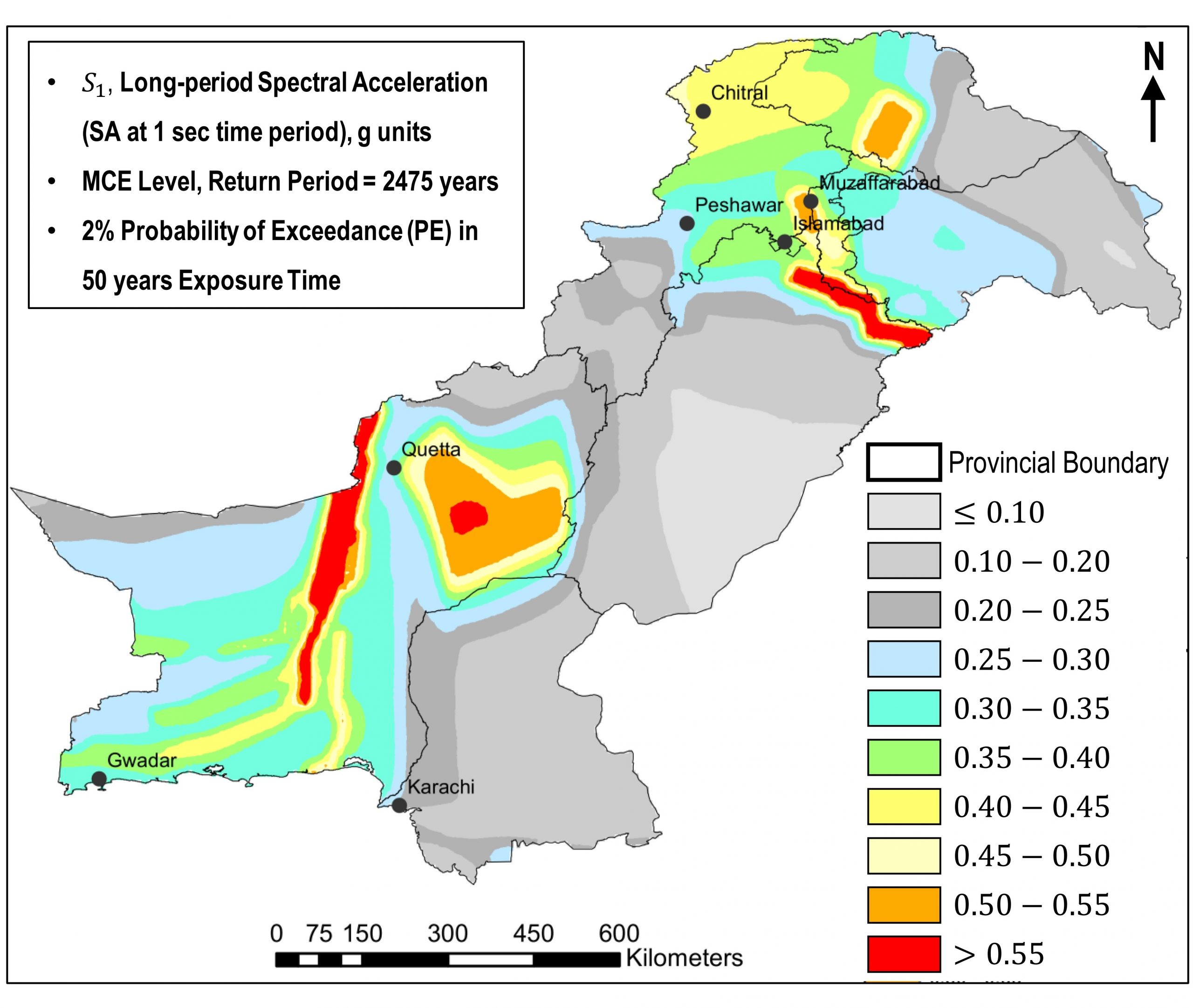
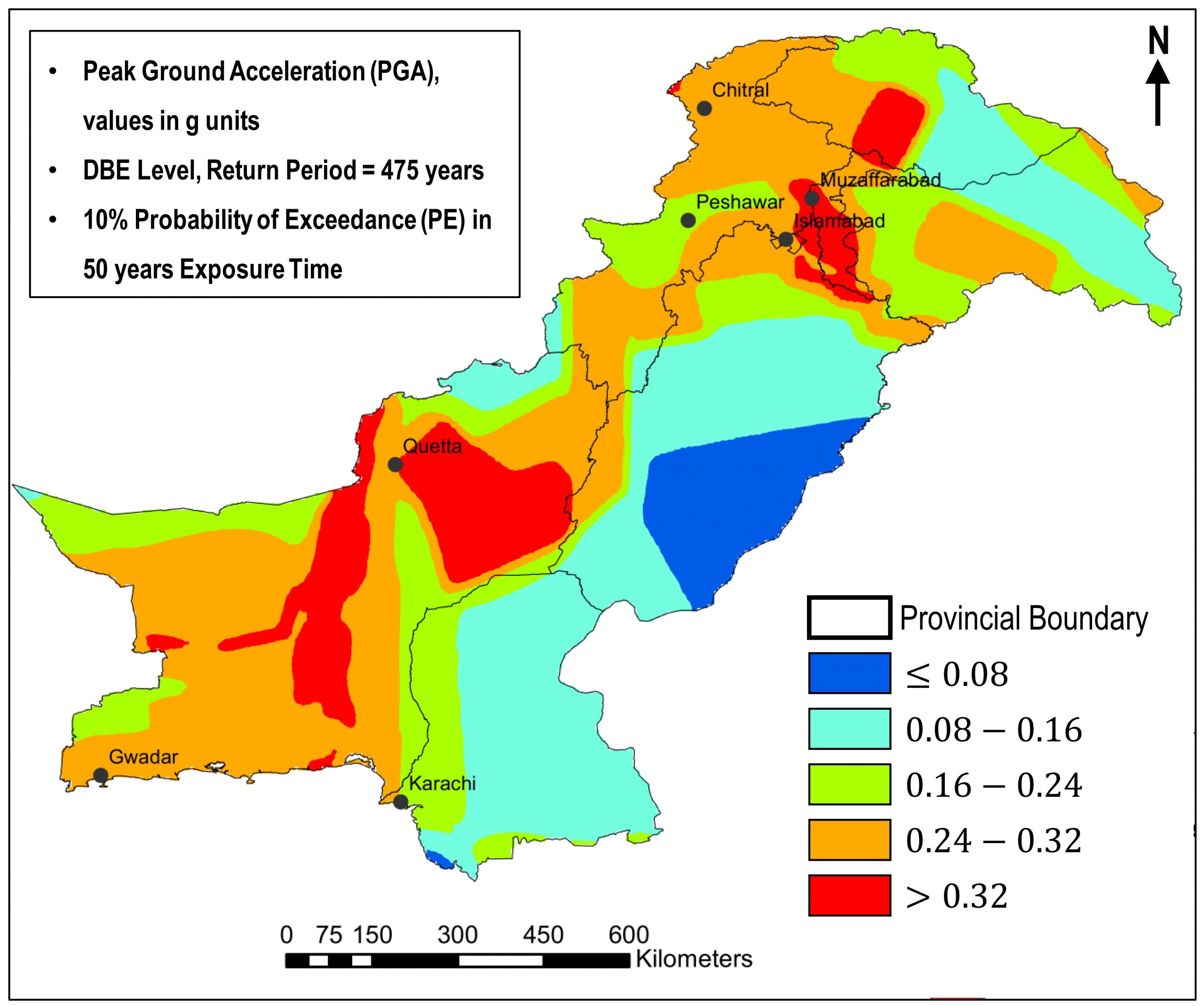
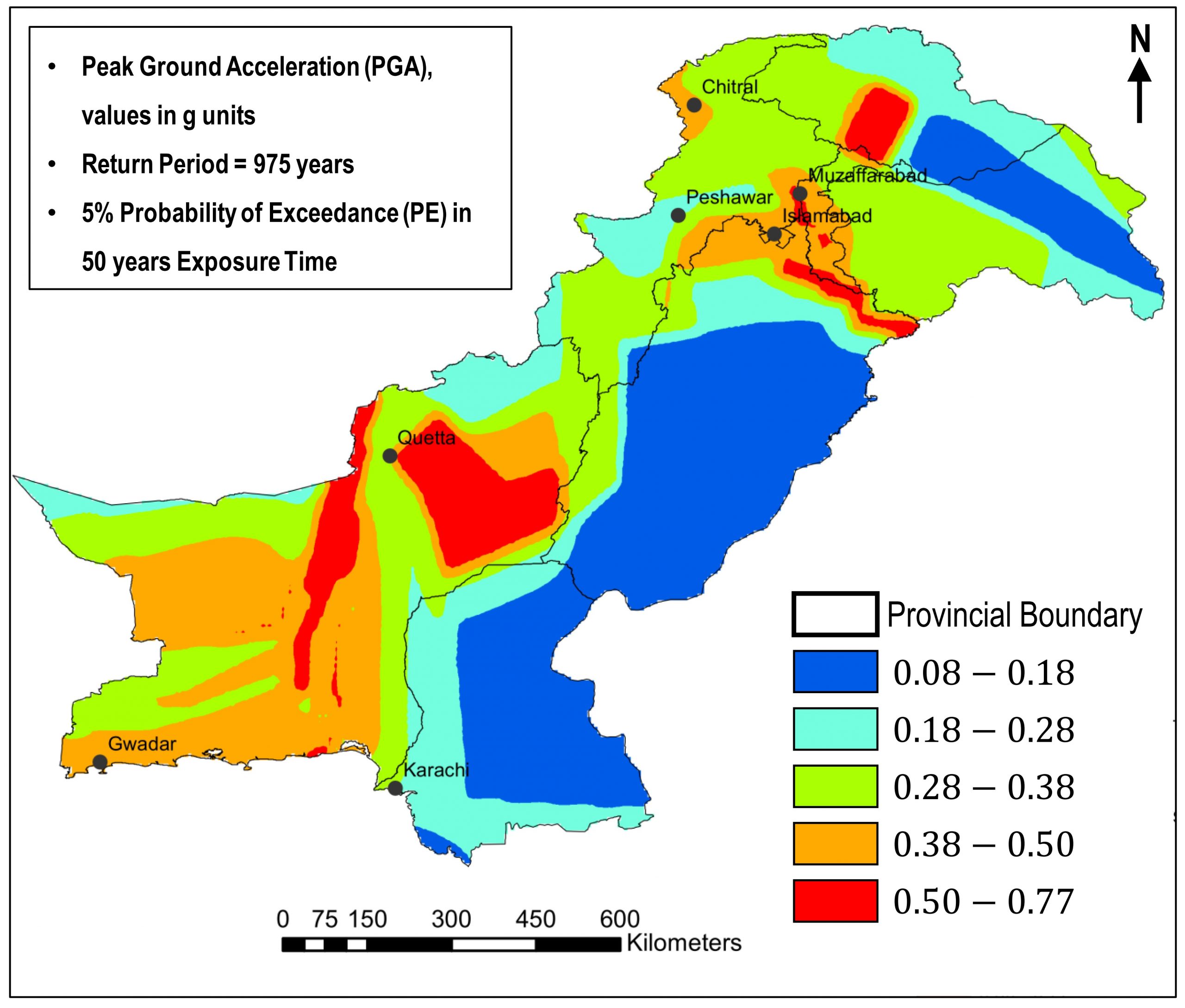
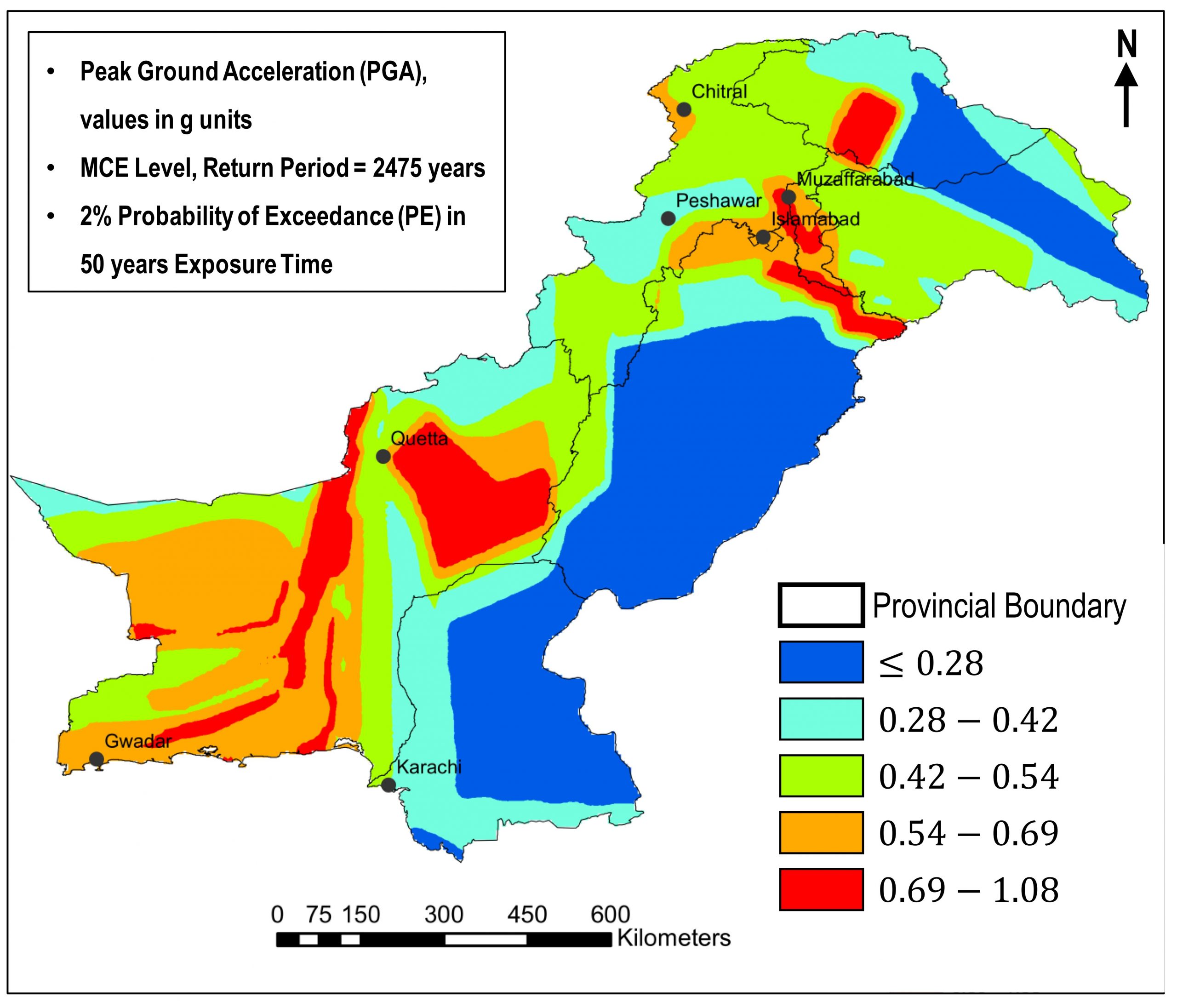
Tabular Values for Seismic Hazard Parameters
The tubular values of seismix hazard parametrs for all major cities of Pakistan are shown below.
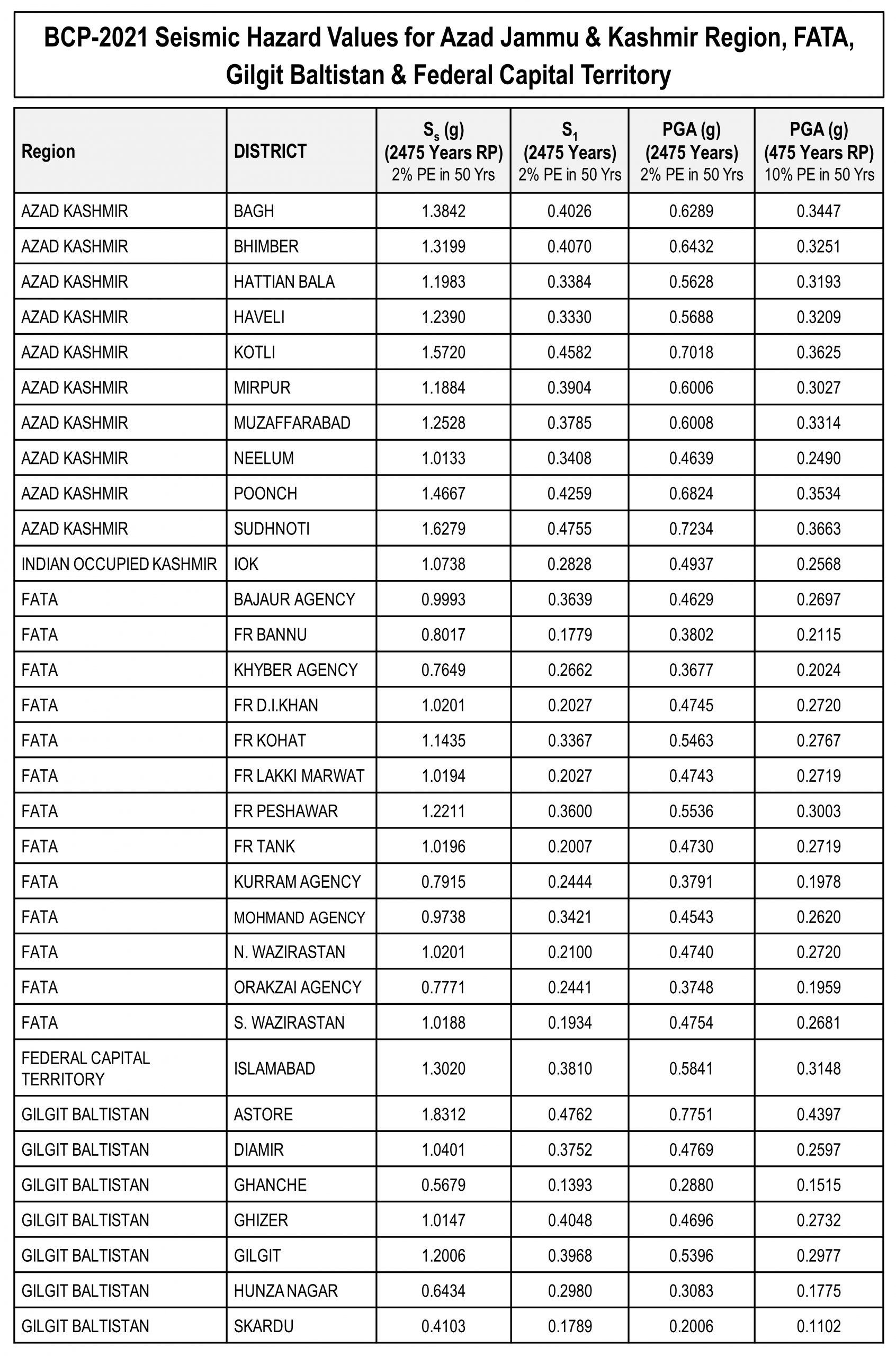
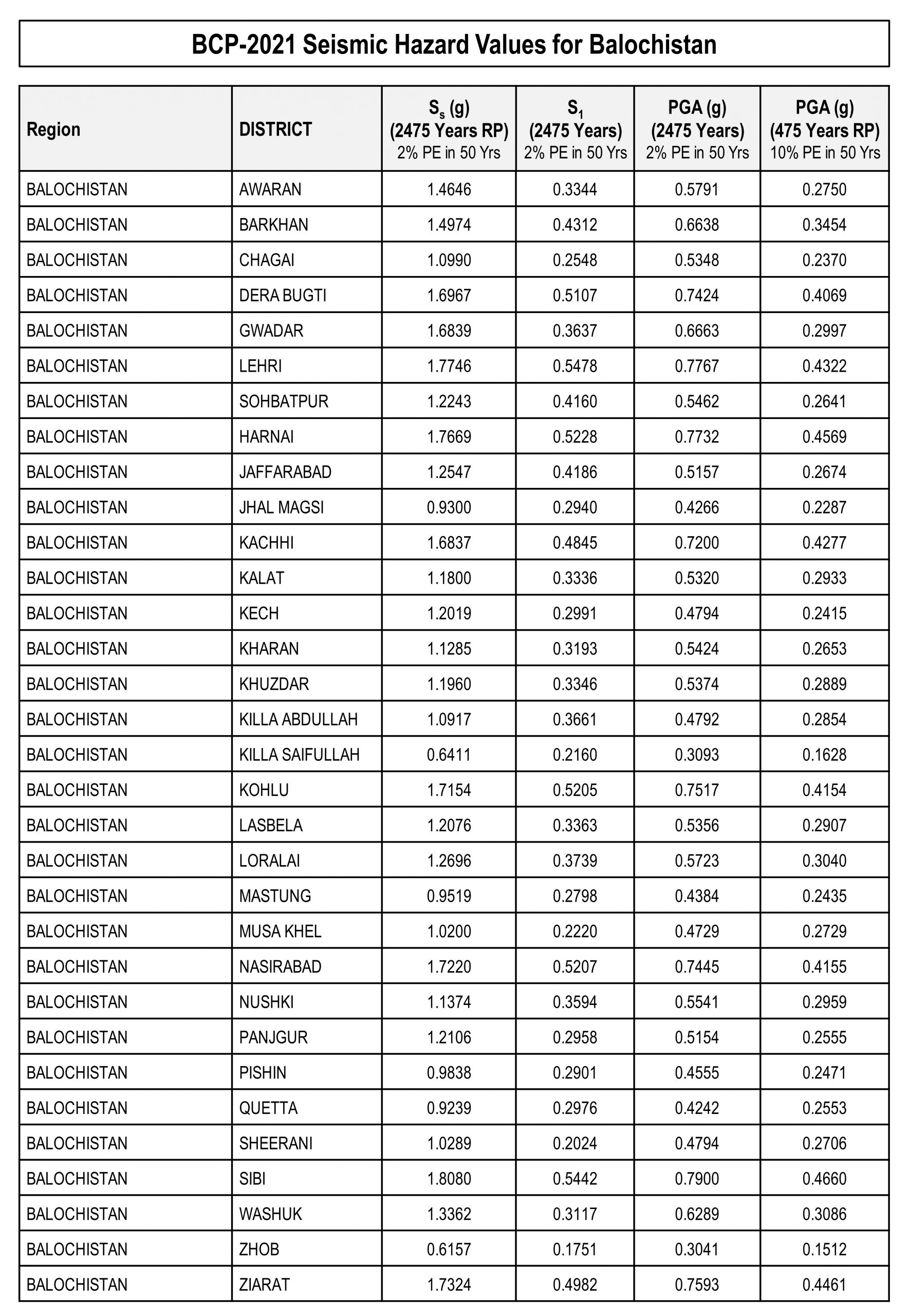
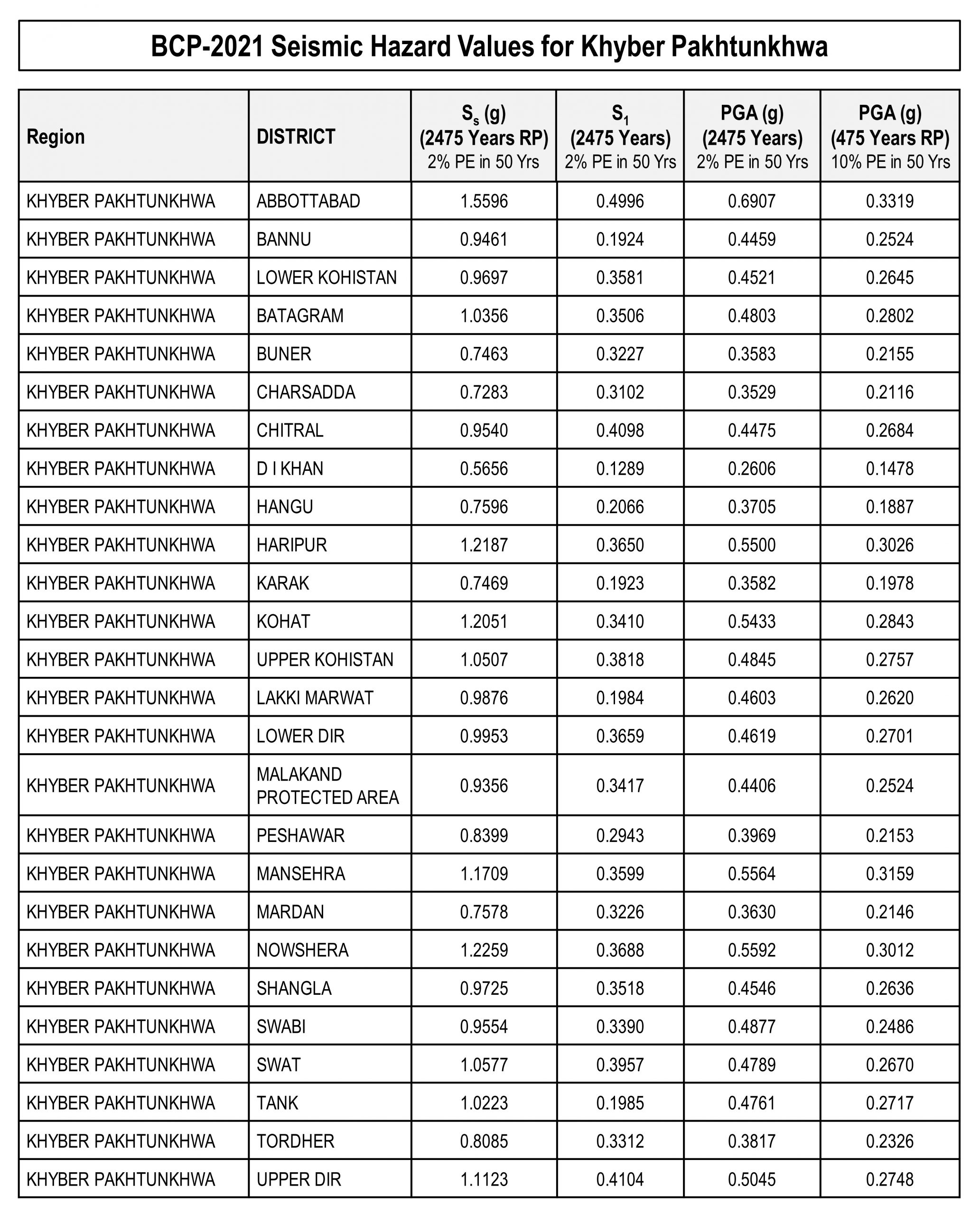
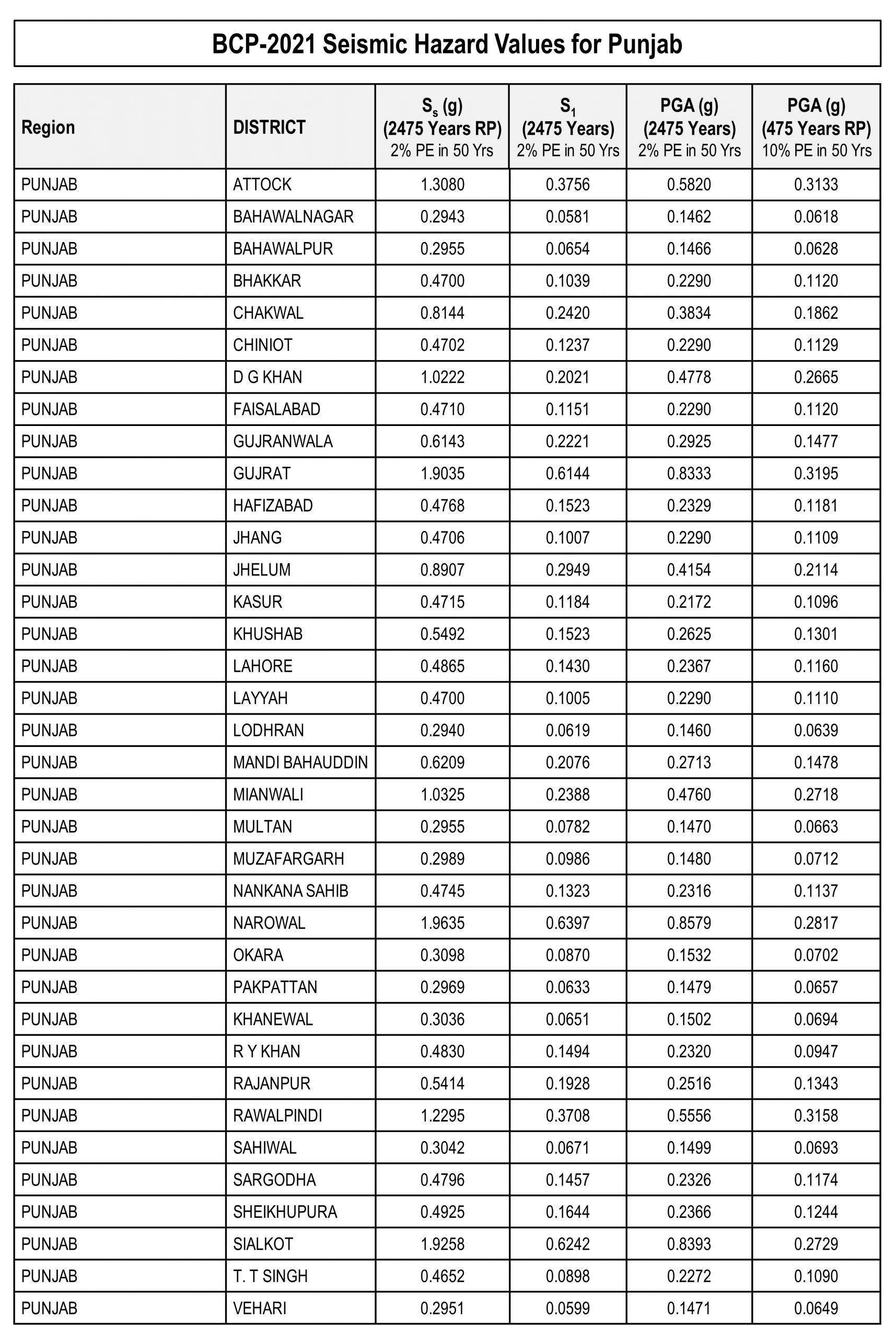

CE - 842: Performance-based Seismic Design of Structures
Description and Rationale
With recent advances in computing and modeling tools, and with growing challenges in terms of increase in population, urbanization, complexities in structural forms and innovative systems, the practicing structural engineers and designers nowadays need to equip themselves with various advanced skills. The demand and complexity is rapidly increasing for built environment including accommodation, offices, and commercial areas to accommodate rapidly growing urban population. Resultantly, the cities and infrastructure of future will need to be denser, complex and taller. These challenges require great expertise and computational capabilities in terms of using state-of-the-art nonlinear analysis procedures, latest computer modeling software and developing insight into the complex dynamic behavior of structures.
Pakistan is located on a highly earthquake-prone and seismically active part of the world. The country lies on a tectonically active Himalayan orogenic belt developed as a result of slow collision (extended over last 30-40 million years) among the Indian, Arabian, and Eurasian tectonic plates. This geological setting has resulted in a number of active seismic sources and faults in the region which are capable of producing moderate- to large-magnitude earthquakes. Besides having a high level of seismic hazard, the country is also confronted over the years with high rate of population increase and rapid growth of urbanization. With all these challenges and high seismic risk, there is an urgent need of equipping the practicing engineers, designers, structural engineering students with state-of-the-art information about the latest structural design philosophies.
The performance-based design (PBD) approach is a recent shift in our understanding of structural design. It provides a systematic and flexible methodology for assessing the structural performance of a building, system or any component, as opposed to the cookbook type design methods prescribed in building codes. This methodology explicitly evaluates the response of the buildings under the potential seismic hazard while considering different probable site-specific seismic demand levels (Service Level Earthquake (SLE) and Maximum Considered Earthquake (MCE)). For this purpose, various state-of-the-art nonlinear analysis procedures and latest computer modeling tools are used to accurately determine the seismic demands of whole structure and its individual components.
This course aims to develop basic expertise and skill among UG students about various practical aspects of seismic design of buildings and structures.
Course Contents
1) Understanding the Seismic Hazard: Introduction to Seismology, Seismic Hazard Assessment
2) Introduction to Performance-based Design Approach: Dynamics of Structures – A Review, Basic Philosophies of Seismic Design of Structures, Introduction to Code-based Seismic Design, Classical Modal Analysis Procedure, Equivalent Lateral Force Procedure, Response Spectrum Analysis Procedure, PBD Basics and Methodology, Structural Performance Levels and Acceptance Criteria
3) Nonlinear Modeling and Behavior of Building Structures: A Quick Overview of Linear Elastic Modeling ( + A Hands-on Training on ETABS 2016), Fundamentals of Nonlinear Modeling – Distributed and Lumped Plasticity Approaches – Hysteretic Behaviors, Strength Loss, Cyclic Degradation, Hands-on Training Session on “PERFORM 3D” (Nonlinear Modeling of various Structural Components)
4) Nonlinear Dynamic Analysis of Buildings: Selection of Seismic Input (Response Spectra and Ground Motion Records) for Dynamic Analysis of Buildings, Scaling and Matching of Ground Motion Records Nonlinear Time History Analysis Procedure (NLTHA), Interpreting the Dynamic Response and Seismic Performance of Buildings, Understanding the Analysis Results from Nonlinear Time History Analysis, Understanding the Analysis Results from Nonlinear Time History Analysis, Maximum Considered Earthquake (MCE) level Evaluation of Structural Performance
5) Additonal Topics: Nonlinear Static Procedures, NSPs (Pushover Analysis Procedures, Capacity Spectrum Method, Displacement Coefficient Method, FEMA 440 NSPs., Introduction to Modal Pushover Analysis (MPA) Procedure and Uncoupled Response History Analysis (UMRHA) Procedures, Ductility Design of Structures, Direct Displacement-based Seismic Design (DDBD) of Structures
6) Term Project: The Performance-based Seismic Evaluation of a Real Case Study Building
Who Should Attend?
The expected audience for this course includes the following.
Masters and Ph.D. students, Structural designers, practicing engineers and consultants, Architects, planners, Real-estate developers and owners
Textbooks, References and Reading Material
Textbooks: Lecture notes provided by instructor
Reference Books
1) T. Pauley, and M. J. N. Priestley, (1992): Seismic Design of Reinforced Concrete and Masonry Buildings, John Wiley and Sons, New York.
2) A. K. Chopra, (1995): Dynamics of Structures-Theory and Applications to Earthquake Engineering, Prentice Hall, New Jersey.
3) R. W. Clough, and J. Penzien, (1993): Dynamics of Structures, McGraw-Hill, New York, 2nd Edition.
4) J. W. Smith, (1988): Vibration of Structures: Applications in Civil Engineering Design, Chapman and Hall, London.
5) W. F. Chen and C. Scawthorn (2003), Earthquake Engineering Handbook.
6) T. Y. Lin and S.D. Stotesbury (1988): Structural Concepts and Systems for Architects and Engineers, 2nd edition, Van Nostrand Reinhold.
7) Graham H. Powell (2010): Modeling for Structural Analysis, Computers & Structures Inc.
8) Edward L. Wilson (2000): Three-Dimensional Static and Dynamic Analysis of Structures, Computers & Structures Inc.
9) Tall and Super-tall Buildings: Planning and Design (2014): Editor: Akbar Tamboli, Publisher: McGraw-Hill Professional, with CTBUH and ICC, ISBN13: 978-0071818711 ISBN: 0071818715
10) James K. Wight (2016): Reinforced concrete: Mechanics and design, 7th edition, Prentice Hall.
11) E. G. Nawy (2009): Reinforced concrete: A Fundamental Approach, 6th edition, Prentice Hall International
12) Arthur H. Nilson, David Darwin, Charles W. Dolan (2005): Design of Concrete Structures, 13th Edition.
13) Bungale S. Taranath (2010): Reinforced Concrete Design of Tall Buildings, Taylor and Francis Group, LLC.
International Standards/Guidelines
1) TBI (2010): Guidelines for Performance-Based Seismic Design of Tall Buildings – PEER
2) FEMA 356 (2000): Pre-standard and Commentary for the Seismic Rehabilitation of Buildings
3) ATC-40 (1996) Seismic Evaluation and Retrofit of Concrete Buildings, USA
4) ASCE/SEI 41-13 (2014): Seismic Rehabilitation of Existing Buildings (ASCE/SEI 41-13)
5) Council on Tall Buildings and Urban-Habitat (2008): Recommendations for the Seismic Design of High-Rise Buildings.
6) PEER/ATC-72-1 (2011): Modeling and Acceptance Criteria for Tall Buildings, USA
7) ASCE 7-16 (2017): Minimum Design Loads and Associated Criteria for Buildings and Other Structures (ASCE/SEI 7-16)
Research Journals:
1) Earthquake Engineering & Structural Dynamics, Wiley
2) Engineering Structures, Elsevier
3) The Structural Design of Tall and Special Buildings
4) Soil Dynamics and Earthquake Engineering, Elsevier
5) Journal of Structural Engineering, ASCE
6) ACI Structural Journal, ACI
7) Structural Engineering International Journal, IABSE
8) Magazine of Concrete Research, ICE
Internet Resources
Useful Websites
1) http://peer.berkeley.edu/
2) https://www.fema.gov/
3) www.ctbuh.org
4) www.structuralengineering.info
5) https://earthquake.usgs.gov/
6) http://www.iris.edu/hq/
7) http://ds.iris.edu/ieb/
Major Ground Motion Databases
1) USGS Earthquake Catalog: https://earthquake.usgs.gov/
2) PEER Ground Motion Database: https://ngawest2.berkeley.edu/site
3) British Geological Survey Database: http://quakes.bgs.ac.uk/
4) COSMOS Ground Motion Data Center: http://www.cosmos-eq.org/
5) K-NET and KiK-net, the NIED Strong-motion Seismograph Network Database: http://www.kyoshin.bosai.go.jp/
Magazines/Articles
http://www.structuremag.org/
https://www.istructe.org
http://ctbuh-korea.org/ijhrb/index.php
https://www.express.pk/story/968021/
http://www.technologyreview.pk/the-science-of-earthquakes/
http://www.technologyreview.pk/12-years-october-earthquake-pakistan-prepared-handle-another-big-one/
Video Playlists
1) Nonlinear Modeling and PERFORM 3D Seminar by Graham H. Powell
Description: Four valuable sessions on nonlinear modeling of structural components + Hands-on training sessions PERFORM 3D.
Link: Click Here
2) Title: “PBD Seminar and Workshop” – AIT Solutions (Youtube Channel)
Description: International Seminar and Workshop on Performance Based Design of Reinforced Concrete Buildings – 27-28 August 2013 – Hosted by the Asian Center for Engineering Computations and Software (ACECOMS) in collaboration with AIT Consulting.
Link: Click Here
3) Computers and Structures, Inc. (Youtube Channel)
Description: CSI Watch and Learn Video Tutorials
Link: Click Here
ETABS: Click Here
PERFORM 3D: Click Here
4) International Seminar on Design of Tall Buildings – November 2016 (Bangkok)
Description: Hands-on training sessions of different finite element modeling and analysis software (SAP, ETABS, SAFE and PERFORM 3D)
Day 1 (Training on Other CSI Software):
Link: Click Here
Day 2 (Training on PERFORM 3D):
Link: Click Here
5) Lecture Series on Performance Based Design: State of Practice for Tall Buildings
Description: A full playlist (presentations) from the 2014 Earthquake Engineering Research Institute (EERI) Technical Seminar Series – “Performance Based Design: State of Practice for Tall Buildings”.
Link: Click Here
6) Talk and Group Panel Discussion on Performance-based Design
Description: Special Talk on PBD by Mr. Ron Klemencic at the Asian Institute of Technology (AIT), Thailand, November 2017.
Link: Click Here
7) Ashraf Habibullah Talks
Description: CSI founder and CEO Ashraf Habibullah talks during a one-day seminar titled “The theory and practice of Performance-Based Design: The Future of Earthquake Engineering.”
Links:
i. The 4 performance levels in PBD
ii. Nonlinear analysis and energy dissipation
iii. Animations in structural engineering
iv. Strength and deformation of tall structures
v. The Advantage of a Ritz Analysis over an Eigen Analysis in Dynamics
vi. The Power of Virtual Work in Deflection Control of Structures
vii. Optimization in Design of Large Steel Structures
8) IRIS Earthquake Science (Youtube Channel)
Description: Official YouTube channel of Incorporated Research Institutions for Seismology
Link: https://www.youtube.com/user/IRISEnO
Grading Scheme
Assignments + Quizzes: 20%
OHT Exams: 30%
Term Project: 10%
End Semester Exam: 50%
Total: 100%
Instructor
Dr. Fawad Ahmed Najam
Assistant Professor (Structural Engineering)
NUST Institute of Civil Engineering (NICE)
School of Civil and Environmental Engineering (SCEE)
National University of Sciences and Technology (NUST)
H-12 Islamabad, Pakistan
Cell: 92-334-5192533, Email: fawad@nice.nust.edu.pk
Office No: 118, 1st Floor, NIT Building, SCEE, NUST
Recent Posts
Some of our recent posts are shown below.
Going beyond the Code !!!
By fawadnajam|2015-05-21T09:10:00+00:00May 21st, 2015|Structural Engineering|0 Comments
In the aftermath of Nepal Earthquake – The Dilemma of a Structural Engineer
By fawadnajam|2015-04-28T06:42:00+00:00April 28th, 2015|Structural Engineering|0 Comments



